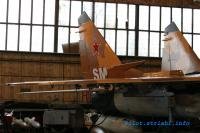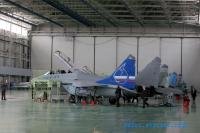
Russia has begun to implement the contract signed by Rosoboronexport with Syria this year for the delivery of five MiG-31E fighter-interceptors. That means that Russia is renewing arms deliveries to the Middle East after a hiatus due to the war in Lebanon. Iran may be the big winner from the deal, since there exists an Iranian-Syrian mutual defense agreement, and Iran is financing Damascus's purchase.
Several sources in the military-industrial complex told Kommersant that OAO Nizhny Novgorod Sokol Plant has begun working on the five MiG-31E aircraft. At the beginning of the year, Rosoboronexport signed a contract with Damascus for them. Since production of the MiG-31 was halted in 1994, Syria is receiving planes from the reserve of the Russian Air Force that are being modified to the purchaser's specifications.
Vladimir Vypryazhkin, deputy general director of the state MiG Russian Aviation Construction Corp. told Kommersant yesterday that “export orders are starting to come in for the MiG-31.” He declined to identify the source of the orders, but noted that “We are offering the MiG-31E on a trade-in basis for countries that have the MiG-25 interceptor.”
Only Libya and Syria have MiG-25 fighter-interceptor and recognizance plane at present. India recently retired its MiG-25s.
Boris Aleshin, chairman of the Federal Industry Agency, confirmed that there is a contract for the MiG-31E. He also declined to identify the purchaser. Kommersant has learned that a lot of MiG-29M/M2 jets was sold to Syria as well. They are being sold abroad for the first time and are similar in their technical specifications to the MiG-35 model Russia is now offering India. The total value of the contract for the MiG-31 and MiG-29M/M2 aircraft is estimated at $1 billion.
Several questions are raised by the deal. First, where Syria got the money for such expensive weapons. In the winter of 2005, Russia wrote off 70 percent of Syria's foreign debt, which was $13.4 billion at the time. Under that agreement, Syria's debt to Russia was reduced to $3.6 billion. Russia renewed military-technical cooperation with Syrian at the same time. Information has arisen regularly since the beginning of 2005 that Syria is in negotiations with Russia for the purchase of new weapons. First Iskander-E missiles were mentioned. Russian President Vladimir Putin even confirmed that Damascus was interested in them, but he supposedly personally blocked the deal. At the beginning of this year, unofficial information emerged that negotiations had been renewed. This time, the items of interest to Syria were Pantsir, Strelets and Igla missiles. Strelets ballistic missiles were delivered to Syria in 2005. Sergey Chemezov, general director of Rosoboronexport, stated in January of this year that “the Syrians want our Igla complex, but we won't give it to them.”
Syrian President Bashar Assad was in Moscow in December of last year for negotiations with Putin, at which Syria's desire to replace its aging MiG-25 planes with new MiG-29 or MiG-31 models.
Western experts think that one of the reasons for Syria's spending spree may be that it is buying weapons for not only for itself, or not for itself at all. Moscow and Damascus concluded a contract last year for the delivery of 36 Pantsir-S1E artillery missile systems. In May of this year, the authoritative British Jane's Defence Weekly reported that at least ten of those Pantsirs would be handed over to Iran by the end of 2008. According to that publication, Iran is the main sponsor of the deal and is paying Syria for its services as intermediary.
There is still no official conformation of the deal described, but the cooperation scheme between Syria and Iran is perfectly believable. Tehran and Damascus are linked by a number of agreements on mutual defense. A Syrian-Iranian strategic alliance was wrought in the 1980s during the Iran-Iraq war. In recent years, Syria and Iran have signed a whole series of agreements on closely coordinated defense activities. In February 2005, for example, almost simultaneously with Russia's forgiveness of much of Syria's debt to it, Syrian Prime Minister Naji Otari and Iranian Vice President Mohammad Reza Aref signed a mutual defense pact and, in July 2006, the defense ministers of the two countries, Hasan Turkmani and Mostafa Mohammad Najar, signed an agreement creating a high defense commission and one on military cooperation that envisaged Iranian financing of Syrian arms deals with Russia, Ukraine and China.
Iran's interest in Russian arms is explained by the conflict developing between it and the United States and the likelihood of armed conflict in the region. In the USSR, the MiG-31 was considered a key element in the defense against a potential attack from the U.S. It was to knock out American cruise missiles flying over the North Pole. The usefulness of that Soviet technology in a potential conflict between the U.S. and Iran is debatable. In the event of a war, Iran's chances of an air victory are negligible, no matter what weapons they buy.
The MiG-31 would do more good for Syria. Head of the Technology and National Security Program at the Holon Institute of Technology and Israeli Air Force Col. (Res.) Shmuel Gordon told Kommersant that “This is the first serious modernization of the Syrian antiaircraft and antimissile system in ten years. It will most likely seriously limit the Israeli Air Force's freedom of action. The appearance of those planes means that the Syrians can take down Israeli planes over the Golan Heights or Lebanon. That is to say this is a quantitative leap in Syria's ability to wage an air war.” Gordon also thought that five planes was but the tip of the iceberg. “It makes little sense to limit oneself to five planes. Where there's five, there will soon be 20, and maybe 24, planes. Maintenance of the planes is very expensive, but it makes no difference whether you maintain five or 20 of them.” Former head of the Israeli Air Force Maj. Gen. Eitan Ben-Eliahu agrees with him. “That can influence the actions of the Israeli Air Force somewhat, but the influence will not be significant. It does not at all change the fact of Israel's absolute air superiority. However, if the number of Syria's planes is increased, that could change the situation. The most dangerous thing for Israel's security is not the delivery of five planes but the renewal of deliveries.”
According to Knesset member and former chairman of the Foreign Affairs and Defense Committee Yuval Steinitz, “It cannot be said that a specific deal is a threat to Israel's security, but the main danger is that it is a matter of a whole package of deals that gradually adds up.” Last year, Israel alleged to Moscow in confidential negotiations that some of the arms it sold to Syria fell into the hands of the Hezbollah and being used in the war in Lebanon last summer.
The sale of Russian jets to Syria will undoubtedly have repercussions in the West. Moscow is not likely to be concerned with American criticism at the moment, since the main problem in U.S.-Russian relations is the U.S. missile defense system in Eastern Europe. Now the two issues may be discussed together.
Iran's position on the missile defense system can be considered indirect confirmation that it is deriving some sort of benefit from the present deal. When Putin suggested to U.S. President George W. Bush that they counter the Iranian threat by using the Gabala radar station in Azerbaijan together, Tehran unexpectedly announced that it does not consider Russia's proposal hostile and that it will not affect Russia's good relations with Iran.
What is the MiG-31?
Development of the MiG-31 supersonic fighter-interceptor (Foxhound in NATO classification) was begun by the Mikoyan Experimental Design Bureau in 1968. The first test flights were performed in 1977 and it went into service in 1981.
The airplane was first created to defend the USSR from cruise missile attacks from the Arctic. A number of weapons systems were used for the first time in the USSR in the MiG-31, including the R-33 long-distance (about 120 km.) air-to-air guided missile and the Zaslon radar system, capable of locating its target at a distance of 180 km. and both guide missiles to it and relay the information to other aircraft and ground facilities.
The MiG-31 has a two-man crew. Its combat radius is 720 km. (1400 km. with external fuel tanks), maximum speed 3000 km./hr. and operational ceiling of 20,600 m. It has a flight weight of 41 tons. Besides missiles, the plane is armed with a 23-mm. gun and two or four short- or medium-range missiles. The MiG-31 was produced at the Sokol plant in Nizhny Novgorod until 1994. More than 500 planes were produced. There are about 300 of them in the Russian Air Force at present and about 40 in Kazakhstan.
Several modifications of the plane have been developed, including the MiG-31M (with a new 320-km. radar system) and MiG-31F (capable of striking ground targets). The MiG-31 has not been used in combat and has not been exported. There were media reported in the early 1990s of interest from Syria, Libya and China in acquiring the aircraft, but no contracts for it were signed.
http://www.kommersant.com/p775460/arms_trade_/


